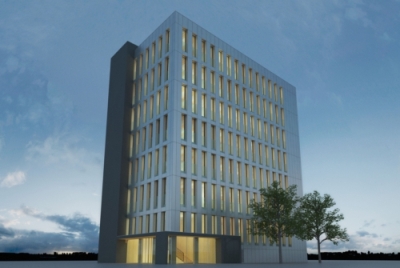Oct 31 2012
The award-winning Austrian green building firm CREE GmbH has opened its U.S. operations in San Francisco, CREE Buildings. The company's innovative timber and concrete hybrid technology enables architects to design stunning tall wood buildings up to 30 stories, that can be erected as quickly as a story a day.
 Wood is the main construction material of the CREE LCT ONE building. Located in Dornbrin, Austria, it features the firm's innovative LifeCycle Tower system, which reduces both construction time and the C02 emissions common with conventional steel and concrete buildings.
Wood is the main construction material of the CREE LCT ONE building. Located in Dornbrin, Austria, it features the firm's innovative LifeCycle Tower system, which reduces both construction time and the C02 emissions common with conventional steel and concrete buildings.
Known as the LifeCycle Tower (LCT) system, CREE's innovation is a slab and post wood design method that requires up to 50% shorter construction time compared to reinforced concrete and steel construction. The LCT system also requires 39% fewer resources, over the life of a building and takes advantage of engineered timber products. By combining wood and concrete together, the LCT system substantially reduces the amount of concrete used in the building, resulting in a lighter structure, with a smaller foundation and up to 90% lower CO2 emissions. Currently, the firm has two buildings established in Austria, with several North American proposals in the works. This innovative tall wood design system will be on exhibit at GreenBuild2012 in San Francisco, November 14-15, at booth #1401S.
"San Francisco is a great place for us," said Michael Zangerl, CEO of CREE Buildings. "Here we are surrounded by the cleantech and sustainable ecosystems, as well as some of the finest architecture firms in the country. Tall wood buildings are the future of sustainable urban development. We are excited to provide cities with this cutting edge design expertise and local timber industries with new markets for their products."
How it works
The CREE LifeCycle Tower is a building system which uses prefabricated components manufactured to an architect's exact specifications. The wall facades are made from glue-laminate posts, while the floor slabs are constructed from a hybrid of glue-laminate posts and concrete. While these components are manufactured off-site, the foundation of a building is laid and the structural elevator shaft core is erected. This core, made out of either steel and concrete or wood, stiffens the building and provides a frame from which the walls and floors can hang. The slabs and posts are assembled by interconnecting the preset pins and holes of the components. With this skeleton structure, architects can design a wide variety of layouts and exterior skins, to create dramatic and sustainable buildings.
"Often people think that a systems approach to building construction hinders architectural design, and leads to modular, boxy, uninspired buildings," said Nabih Tahan, Chief Sustainable Officer of CREE Buildings. "However, the CREE LCT system involves only the components of the building structure. This allows for outstanding architectural freedom on the look and feel of the building. Our LCT ONE and the IZM Montafon building look completely different, yet they are built from the same basic components."
CREE's first building is its global headquarters in Dornbirn, Austria called the LCT ONE. Built to a passive house standard, the eight-story pilot project was erected in eight days after the foundation was finished. The company's second building is the Illwerke Zentrum Montafon (IZM) Montafon building in Montafon, Austria. Currently under construction, this is CREE's first commissioned project and is set to be one of the largest tall wood commercial buildings in Europe.
The LCT buildings are highly durable, fire and earthquake safe, and conform to local building codes. At the end of their lives, the building materials can be efficiently reused, recycled or converted into bioenergy.